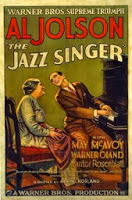Breaking into show business has never been easy. Like many early twentieth century entertainers, Asa Yoelson (1886-1950), along with his brother Hirsh (Harry), moved from singing on the streets to performing in a traveling circus, a burlesque show and in Vaudeville. His progression through the theater world transformed him from Asa Yoelson to Al Joelson and finally to Al Jolson.
In 1904, as a means of reducing stage anxiety, Jolson covered his face in burnt cork, appearing in what was then called “blackface.” The persona he created as a blackface comedic singer propelled him to stardom.
In 1911, Jolson appeared on Broadway for the first time in La Bell Paree, a variety show that ran at the new Winter Garden Theater. In his second Broadway show, The Whirl of Society, Jolson introduced his blackface alter-ego Gus, a persona he would eventually bring out in multiple roles and performances.

Al Jolson is best known for his role in The Jazz Singer, the first full-length talking motion picture. Surprisingly, Jolson was not the producers’ first choice for the film that seems to replicate Jolson’s own biography. The protagonist, Jack Robin, chooses an entertainment career over following his family tradition of becoming a cantor. Jolson’s own father was a rabbi who was greatly disturbed by the non-religious lifestyles adopted by both his sons. (At the end of The Jazz Singer, Jack Robin agrees to take the place of his dying father and lead Kol Nidre.)
The Jazz Singer was the pinnacle of Jolson’s career. After several more movies and Broadway productions, Jolson headed overseas to entertain the troops during World War II. Two movies, The Jolson Story (1946) and Jolson Sings Again (1949), were loosely based on his life.
In September 1950, Jolson flew to Korea and gave 42 performances in seven days to US troops. One month later, on October 23, he suffered a fatal heart attack.
Copyright © 2013 NJOP. All rights reserved.
Related Posts
A Singer whose Voice was a Pen
On November 21, 1902, a baby was born in Leoncin, Poland, who would succeed, through…
0 Comments3 Minutes
All That Jazz
Jewish Treats presents a short biography of Artie Shaw, who often competed with Benny…
0 Comments2 Minutes
A Jazz Master
On a day dedicated to the appreciation of the saxophone, Jewish Treats presents the…
0 Comments2 Minutes
 Print This Page
Print This Page